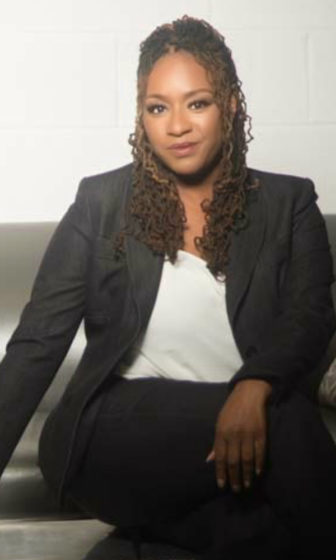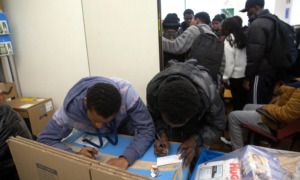
FCSCAFEINE/Shutterstock
.
When a young person experiences trauma, there is no single answer regarding how that experience may impact them in their later years. Two 12-year-olds experiencing the exact same kind of trauma, for example, may have two very different responses — one crumbles and the other rises. One processes it deeply and the other suppresses it. One becomes a powerful force for change in the community and the other struggles to make their place in the world.
Furthermore, what may be considered traumatic for one person may not be for another. It can take many forms and yield remarkably different results. I am going to dissect the concept of growth after trauma by using hope as a catalyst for positive life change.
Post-Traumatic Growth

Pamela Larde
Post-traumatic growth is not just about surviving a traumatic experience. It is not resilience — though it can lead to greater resilience later in life. It is not having the ability to heal and move on with life. It is the equivalent of developing a new superpower as a result of a traumatic experience. It is life improvement and empowerment that serves not only the individual experiencing the growth, but also those whose lives are touched by that individual’s growth.
The Posttraumatic Growth Research Group at the University of North Carolina Charlotte, which coined the term, describes post-traumatic growth as positive change experienced as a result of the struggle with a major life crisis or a traumatic event. This is not to say that the traumatic experience was good or that everyone who experiences trauma has the support and resources needed to experience growth, but the research does offer ideas about how some people manage to grow after trauma, and one of those ideas is hope.
Hope After Crisis
Chelsea is one example of how a young person experiencing years of living in crisis can follow a path of hope to create positive life change. I interviewed Chelsea for a study on post-traumatic growth. She shared her story of being homeless throughout much of her middle school and high school years and the shame she experienced as she went to great lengths to keep her homelessness a secret. Today, she is a thriving professional who uses her career to positively influence struggling youth.
Memories of her adolescence are colored with grey experiences of separated parents, of her and her mother living in their car and of moving from place to place to dodge harassment from the police. It was a secret Chelsea desperately kept for fear that she would be humiliated or ostracized in front of her peers. As is the case with many adolescents, she struggled with self-esteem, and with each passing year through middle school and high school, her struggle only intensified.
Socially, she felt awkward and out of place among her classmates. Many of them knew each other well because they grew up in neighborhoods together, but no one knew the place she called home. To keep this secret, Chelsea made it a point to stay busy at school by engaging in after-school activities. It was where she could connect with others on equal ground and where she eventually found the support she needed to change the tide of her life.
A creative at heart, Chelsea engaged in as many of the arts as possible, including theater, dance, chorus and writing. Going home was difficult and heart-breaking, but school gave her hope for the future. It was her safe haven. After-school is where she found teachers and mentors who cared enough to offer support, advice and opportunities for her future. If she could just push through, she knew she would go to college. Hope was taking form in her life.
Hope in a Wildly Cold World
Every now and then, we are graced with a news story that reinforces our sense of hope. Maybe no one died in the shooting this time. Perhaps the hurricane will go around the poor, impoverished village. Hopefully that abused child will survive and finally get to experience a better life.
Most recently, that story was that of the 12 soccer players who were miraculously rescued from a deep, slowly flooding cave in the mountains of Thailand. The first victory was that after weeks of searching, the missing team of youth and their coach had been found. But that was only the first obstacle. The world remained on edge for weeks as experts weighed the pros and cons of proposed rescue strategies, all while racing against time and nature to make what seemed to be the impossible happen.
Several factors were at play: The water was slowly rising, threatening to flood the cave at any time; none of the 12 boys knew how to swim, and getting out required swimming through parts of the cave that were fully submerged in water. One rescuer had already lost his life in an attempt to transport oxygen tanks to the kids before the operation began. It didn’t look good. The odds were against them, but hope never seemed to waver.
We, the onlookers of the world, braced ourselves because truly, we did need a win in light of the hopelessly negative news that has inundated social media and our airways lately. We braced ourselves and held on to hope that this story would end well. And in a turn of events that culminated in the ending we all needed, all 12 of the boys were rescued — boys who were not skilled in navigating the terrain that lay before them. But they did it. Hope won.
The Research on Hope
When former President Barack Obama launched his presidential campaign in 2008, he did so under the banner of hope. It was a banner that triggered a storm of criticism, even from those who believed in his platform. Hope is too abstract. It is naïve. It has no weight. Hope is a warm and fuzzy feeling without a plan.
Yet, even in light of the criticism, much of the nation was won over by this idea of hope. Like watching the rescue of the boys in Thailand, we wanted hope to work. We wanted to believe that hope would lead to change. And we wanted to reclaim the hope we once had in the days of our youth. Hope feels good when the result is success or survival. But all too often, our lifted spirits are met with heartbreak and disappointment, and over time, as a society, we begin to lose that hope.
The true manifestation of hope is much more than just a good feeling. Contrary to popular belief, it is indeed a strategy. We don’t often speak of hope in this way, but positive psychologists like Charles R. Snyder have been doing work on the concept of hope for decades. As it turns out, there is a formula for hope, and its components include the practical, action-oriented elements that many critics of hope claim are missing. According to Snyder, sustainable hope — high hope, as he calls it — requires two elements: agency and pathways.
Snyder demonstrates that hope is possible when agency and pathways are present and recognizable. Agency is our internal reservoir. It is our sense of ability, freedom, strength and will to pursue our interests and desires. We perceive that our lives are in our control and that we have the ability to reach the dreams we hope for.
Pathways consists of what is external to us. This includes the resources and forms of support outside ourselves that we recognize as available to help us achieve what we hope for – like financial aid for college, a therapist to overcome a traumatic experience or a vehicle to get to work each day. The combination of agency and pathways is what allows us to have hope and to find the resiliency to survive. Understanding this could serve as a powerful tool in our work with youth who struggle to see hope for their futures.
Applying Agency and Pathways
In the case of the soccer team rescue, we learned of two very important agency strategies that contributed to their rescue: (1) the rescuers taught them to swim so that they could, in a sense, help save themselves and (2), the coach taught them meditation skills that enabled them to stay calm throughout the entire process. With the absence of just one of these agency strategies, they may not have made it out alive.
The pathways were also present — rescuers, numerous escape strategies, health professionals and safety equipment — but without the boys having their own sense of agency, each of these pathways stood the risk of being unsuccessful. The physical and psychological impacts of this potentially traumatic experience remains to be seen, but what is known is that because these boys were equipped with the coping skills of meditation and the elements of hope, their chances of experiencing growth after this ordeal are great.
In Chelsea’s story, she activated her own sense of agency when she took the initiative to join numerous after-school programs. When she spoke with teachers and counselors, they became her resources — or her pathways to the military and eventually to and through college. The combination of her agency and the pathways she identified undoubtedly created a hope that triggered change in her life. Even as she struggled with self-esteem and fitting in, Chelsea managed to devise a plan of her own to survive homelessness without being consumed by it and to eventually create a life dedicated to positively impacting others.
With so much exposure to the ongoing traumatic events that occur all over the world, how do we inoculate our youth against the tragedy of losing hope in society and, more importantly, in themselves? We do so by instilling, not just a sense of hope, but by instilling practical strategies for hope. This includes helping them recognize their own agency by showing them their strengths and arming them with self-empowerment skills, like problem–solving, meditation or relationship-building.
And it includes helping them identify the pathways by engaging in strategic conversations and offering informational and material resources. In even the most dire, life-threatening of situations, if we arm them with a sense of agency and the ability to identify pathways, they too can possess the hope it takes to aid in their own rescue. As the saying goes, it takes a village. It does. But if that village fails to arm them with the ingredients for hope, especially after trauma, they may very well drown in their own fear.
Pamela Larde, Ph.D., is an associate professor of research at Mercer University, an Institute of Coaching Fellow at Harvard Medical School’s McLean Hospital and a certified life coach. She has written four books and contributed chapters to various academic texts.






























